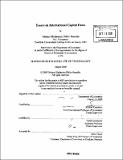Essays on international capital flows
Author(s)
Brandão, Tatiana Glindmeier Didier
DownloadFull printable version (15.89Mb)
Other Contributors
Massachusetts Institute of Technology. Dept. of Economics.
Advisor
Ricardo Caballero and Guido Lorenzoni.
Terms of use
Metadata
Show full item recordAbstract
This dissertation consists of three chapters on international capital flows. Chapter 1 emphasizes the importance of innovations in the investment opportunity set, captured by changes in expected asset returns, as an important mechanism to explain international capital flows. More specifically, it analyzes the implications of time-varying portfolio shares on the dynamics of the current account. The predictions of a partial-equilibrium model of the current account, with dynamic portfolio choices, are evaluated using data for the U.S. and Japan. We show that variations in investment opportunities change agents' optimal portfolios in a direction consistent with the actual bilateral current account movements. Chapter 2 focuses on two questions related to international investment and access to international capital markets. First, does the structural change in the U.S. mutual fund industry toward more "aggregation" (favoring funds that invest globally over funds that invest in specific countries or regions) affect firms in other countries? And second, are investors forgoing gains from international diversification by shifting toward more global funds? The empirical evidence presented suggests that the answer is yes to both questions. Chapter 3 investigates the relation between information asymmetries and institutional investor mandate. The results suggest that information asymmetries vary across institutional investor mandates, being significantly more pronounced for funds with broader mandates.
Description
Thesis (Ph. D.)--Massachusetts Institute of Technology, Dept. of Economics, 2008. Includes bibliographical references.
Date issued
2008Department
Massachusetts Institute of Technology. Department of EconomicsPublisher
Massachusetts Institute of Technology
Keywords
Economics.